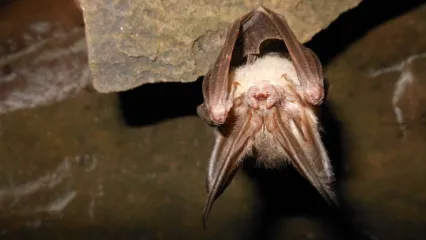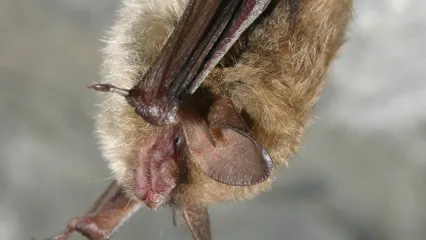
Description
The Ozark big-eared bat is the largest subspecies of the Townsend’s big-eared bat species complex, which has a relatively wide distribution throughout both western and portions of eastern North America. It is a medium-sized bat with dark reddish-brown fur, large ears (about four times the length found on most Oklahoma bats), and two prominent lumps on the snout. Its weight varies between that of a U.S. quarter and half-dollar, with total length of 3.5-4.5 inches and has a wingspan of 11.5-12.5 inches.
Size
3.5-4.5 inches in length. 11.5-12.5 inch wingspan.
Habitat
Ozark big-eared bats may have historically occurred in at least five Oklahoma counties; however, current populations are only known in Adair, Cherokee, and Sequoyah counties. A total of ten sites in Oklahoma are known to be essential to the Ozark big-eared bat; however solitary males often roost by themselves in smaller crevices and cliff overhangs. This species also occurs in Arkansas and historically occurred in southwest Missouri. Ozark big- eared bats live in limestone and sandstone talus caves found in oak-hickory forests of the Ozark highlands. This species requires certain micro-climate conditions within caves and often selects areas near a cave’s entrance. Foraging occurs along forest edges within 1 to 5 miles of caves.
Life Cycle
A true cave obligate, the Ozark big-eared bat relies on caves as both maternity sites for raising young and as winter hibernation sites, or hibernacula. It is non-migratory and individual bats often use the same caves year to year. Unlike many bats, this species will frequently wake up during hibernation periods and move between hibernacula sites, even occasionally to feed. Moths are the insect group most often targeted by foraging Ozark big-eared bats, in some cases making up more than 80 percent of their diet by volume. These bats mate in late fall, but embryo development does not begin in females until after bats arouse from hibernation in the spring. Ozark big-eared bats only give birth to one pup a year and the young are typically weaned by six weeks of age.
During certain periods in their life cycle, Ozark big-eared bats are very sensitive to disturbance. Human visitation and vandalism of occupied caves can cause cave abandonment. Too many arousals during hibernation can exhaust a bat’s limited fat reserves and result in mortality. This subspecies is also a regional endemic to the Ozark highlands, placing it at a higher risk of being impacted by habitat loss and other manmade factors. Considered to be one of the rarest mammals in the state, the total population of Ozark big-eared bats is estimated to be less than 2,000 individuals. Since 1993, the Wildlife Diversity Program has partnered with Rogers State University through ESA Section 6 funding to install protective steel gates at the entrances of several important caves used by both gray bats and Ozark big- eared bats. To date, entrances to six essential Ozark big-eared bat caves in Oklahoma have been gated through this long-term collaboration. These protective gates have demonstrated a positive effect on Ozark big-eared bat colonies in at least two caves in Adair County, as evident by higher numbers of bats counted during both winter hibernation and summer emergence surveys after gating. Each year, the U.S. Fish and Wildlife Service conducts emergence counts for Ozark big-eared bat colonies.
How To Observe
For more information about this and other bats, download the free "Bats of Oklahoma Field Guide."


